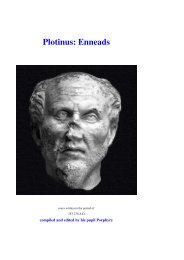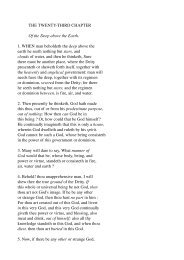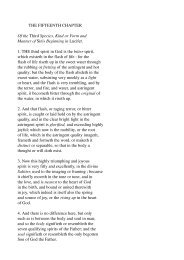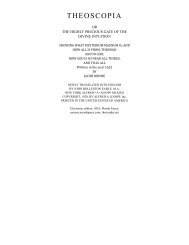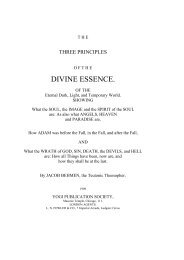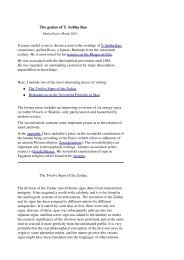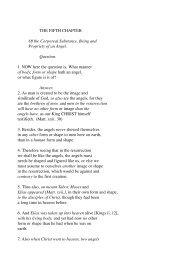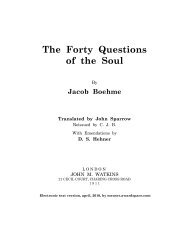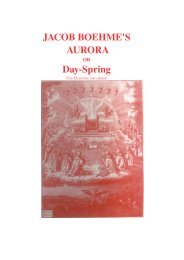Gerald Massey's Lectures - Society in evolution - Awardspace
Gerald Massey's Lectures - Society in evolution - Awardspace
Gerald Massey's Lectures - Society in evolution - Awardspace
You also want an ePaper? Increase the reach of your titles
YUMPU automatically turns print PDFs into web optimized ePapers that Google loves.
historical. As Irenæus declares, accord<strong>in</strong>g to no one gospel of the heretics could the<br />
Christ become flesh; consequently the gospel of Marcion, who was the arch-heretic and<br />
very Anti-Christ of the second century, <strong>in</strong> the sight of the <strong>in</strong>cipient Catholic Church,<br />
could not have been a gospel of the Christ made historical; and we have now the means<br />
of prov<strong>in</strong>g that it was not. When once we know that the orig<strong>in</strong>s were mythical, that the<br />
Christ was mystical, and the teach<strong>in</strong>gs <strong>in</strong> the mysteries were typical, we shall be able to<br />
utilise the gospel of Marcion as a connect<strong>in</strong>g l<strong>in</strong>k between the Egyptian Mythos, the<br />
epistle of the Word of Truth, and the canonical history accord<strong>in</strong>g to Luke.<br />
"The Lord" had been Horus by name <strong>in</strong> Egypt, and the Greek kuriou, or kurios, agrees<br />
with the Egyptian kheru, for the Word, Voice, or Logos, as <strong>in</strong> Ma-kheru (earlier, Makhuru).<br />
This was the Lord cont<strong>in</strong>ued as the Gnostic manifestor, their Horus, or Christ.<br />
Marcion assigned his gospel to the Christ, <strong>in</strong> the same way that the Egyptian Ritual is<br />
ascribed to Hermes. Later on, the say<strong>in</strong>gs of the Lord were also called the writ<strong>in</strong>gs, as we<br />
see by pseudo-Dionysius, who charges the Gnostics with hav<strong>in</strong>g falsified the Writ<strong>in</strong>gs of<br />
the Lord.<br />
Marcion claimed that his was the one true Gospel--the one--and he po<strong>in</strong>ted to the<br />
multiplicity of the Catholic Gospels, full as they were of discrepancies, <strong>in</strong> proof that they<br />
could not be genu<strong>in</strong>e. In the fourth century even, there were as many different gospels as<br />
texts. As transmitted to us by the Christian copyists, who were noth<strong>in</strong>g if not<br />
historicisers, Marcion's gospel opens with the statement, that "In the fifteenth year of the<br />
reign of Tiberius Cæsar, Pontius Pilate rul<strong>in</strong>g <strong>in</strong> Judea, Jesus came down to Capernaum, a<br />
city of Galilee," or "<strong>in</strong>to Judea," as reported by Irenæus.<br />
Tertullian says,--"Accord<strong>in</strong>g to the gospel of Marcion, <strong>in</strong> the fifteenth year of Tiberius,<br />
Christ Jesus deigned to emanate from heaven, a salutary spirit." But, he also says,<br />
accord<strong>in</strong>g to this "Great Anti-Christian," the Christ was a phantom, who appeared<br />
suddenly at the synagogue of Capernaum <strong>in</strong> the likeness of a full-grown man for the<br />
purpose of protest<strong>in</strong>g aga<strong>in</strong>st the law and the prophets! It would be difficult to date the<br />
descent of a phantom Christ, and impossible to date the descent of the Gnostic Christ at<br />
all, except as Lord of the æon <strong>in</strong> relation to an astronomical period! But it is certa<strong>in</strong> that<br />
the Lord or Christ of Marcion is entirely non-historical. He has no genealogy or Jewish<br />
l<strong>in</strong>e of descent; no earthly mother, no father, no mundane birthplace or human birth. The<br />
Gnostic nature of this Christ is further and fully corroborated by both Irenæus and<br />
Tertullian. Clearly then noth<strong>in</strong>g can be made of the statement on behalf of the Canonical<br />
history. This statement <strong>in</strong> Marcion's gospel takes the place of the baptism and descent of<br />
the holy spirit <strong>in</strong> Luke's; and this same date is quoted by Luke for the time when the<br />
Word of God came to John <strong>in</strong> the wilderness, which is followed by the baptism of Jesus<br />
and the transformation <strong>in</strong>to the Christ or Horus of 30 years, whose unpronounceable<br />
name conta<strong>in</strong>ed 30 letters, accord<strong>in</strong>g to the Gnosis. Such a beg<strong>in</strong>n<strong>in</strong>g is entirely<br />
unhistorical, and applicable solely to the mythical Christ, who became the virile adult, the<br />
ano<strong>in</strong>ted son of the father at 30 years of age. Of course Christian apologists like Irenæus<br />
and Tertullian ma<strong>in</strong>ta<strong>in</strong>ed that Marcion had mutilated their version of Luke; and they<br />
managed to get rid of the "Gospel of the Lord," and to suppress the writ<strong>in</strong>gs of Marcion<br />
<strong>in</strong> proof to save us the trouble of judg<strong>in</strong>g for ourselves. But that was only another<br />
Christian lie, as we have now the means of know<strong>in</strong>g. The Gnostics were not the falsifiers<br />
of the historic scriptures; it was not they who had anyth<strong>in</strong>g to falsify! Hitherto the forgers<br />
and falsifiers have been believed, and now the accusers and accused are about to change<br />
places <strong>in</strong> the witness-box and the dock. Everywhere the Gnosis was first; the history was<br />
last. You are only asked to take this view tentatively, and then let us watch the process<br />
and see how the compilers and forgers of our Luke put <strong>in</strong> the touches by which the<br />
mythos was rationalized and the human history was added to the Gnostic "Gospel of the<br />
Lord." The "Say<strong>in</strong>gs of the Lord" were first, and they were not personal. The "Gospel of<br />
the Lord" was first, and the Lord was not historical.



